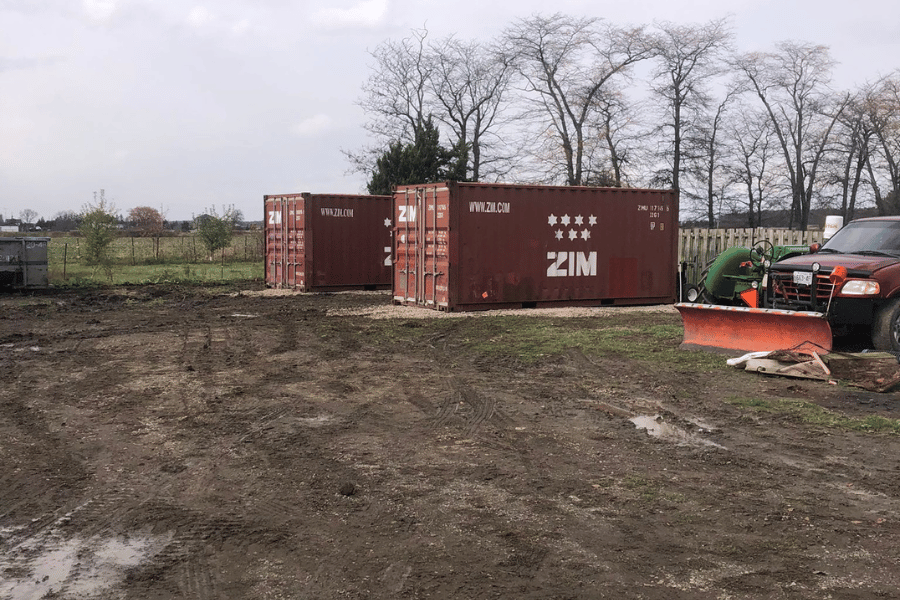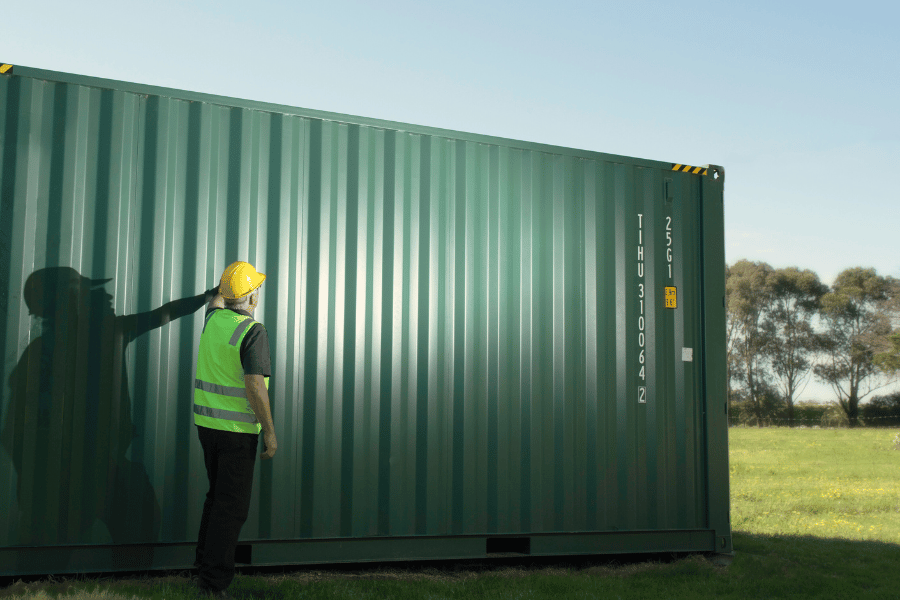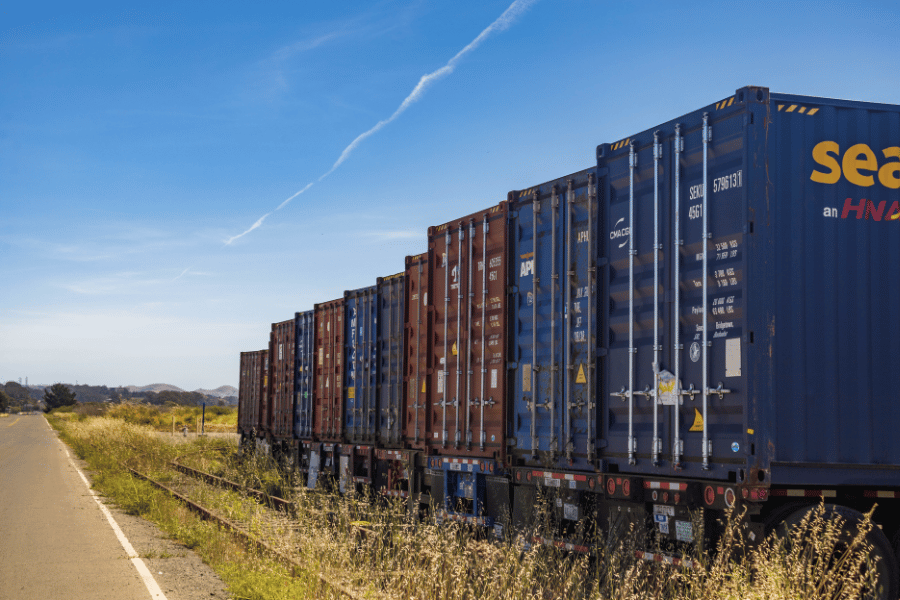Essential Tips for Contractors and Event Organizers
Shipping containers are versatile and durable, making them a popular choice for on-site storage among contractors and event organizers. However, the placement of these containers is crucial to ensure they remain stable and functional. One common question is whether a shipping container can be placed on grass. In this article, we’ll explore the challenges, maintenance tips, and alternative solutions for placing shipping containers on soft ground.

Understanding the Challenges of Placing Containers on Grass
Placing a shipping container on grass may seem convenient and cost-effective, especially when a hard surface is not readily available. However, this seemingly simple solution comes with significant challenges that can affect the stability and usability of the container. Grass and other soft ground types lack the structural support needed to evenly distribute the weight of a shipping container. As a result, the corners of the container can sink into the ground over time, particularly under heavy loads or in wet conditions. This sinking can lead to uneven settling, causing various structural issues that compromise the container’s functionality.
One of the most common issues arising from placing a container on grass is a condition known as racking out. Racking out occurs when the container becomes uneven, which can distort its rectangular shape and affect its overall structural integrity. This distortion can make the container difficult to open and close, and may even lead to permanent damage if not addressed promptly. Additionally, an uneven container can pose safety hazards, making it less secure and stable for storing valuable items. Understanding these challenges is crucial for anyone considering using a shipping container on grass, as it underscores the importance of proper placement and maintenance to ensure long-term functionality and safety.
Why Full Support is Crucial
For a shipping container to remain level and stable, it is essential to provide full support on a hard, level surface. The structural integrity of a shipping container relies heavily on an even distribution of weight, which can only be achieved with a stable foundation. Without this proper support, containers placed on grass or other soft ground are likely to sink over time. As the ground beneath shifts or compresses, the container can settle unevenly, leading to a host of structural problems. One of the most immediate issues is that the doors may become misaligned. When a container is not level, the doors can warp or bind, making them difficult to open or close properly. This can severely impact the accessibility and usability of the container, particularly if it is being used for frequent access storage.
Proper support not only keeps the container level but also ensures it remains functional and safe to use. When a container is properly supported, it maintains its structural integrity, preventing distortions and potential damage. This stability is crucial for the longevity of the container, especially when it is used to store valuable or sensitive items. A container that sinks or tilts can also become a safety hazard. Uneven settling can lead to instability, increasing the risk of the container tipping over or collapsing, particularly under heavy loads. Additionally, a container that is not properly supported is more susceptible to weather-related damage, such as water infiltration during heavy rains. By ensuring that your shipping container is placed on a hard, level surface, you not only protect the contents within but also extend the life of the container itself, ensuring it remains a reliable storage solution.

Maintenance Tips for Containers on Bare Earth
If placing a container on grass or bare earth is unavoidable, regular maintenance is essential to prevent any potential issues. It’s important to check the container every month to ensure it is not sinking or tilting. Over time, soft ground can cause the container to shift, which can lead to doors becoming misaligned or the container becoming difficult to access. Regular inspections will help you identify any problems early, allowing you to take corrective action before any significant damage occurs. If any movement is detected, consider relocating the container to a more stable surface to maintain its structural integrity and functionality.
One practical solution to mitigate the risks associated with placing a container on soft ground is to prepare a simple, three-inch deep gravel pad. This gravel pad serves multiple purposes: it facilitates proper drainage, preventing water accumulation that could further soften the ground, and it helps level out any irregularities in the terrain. To create a gravel pad, start by clearing the area where the container will be placed. Excavate the ground to a depth of three inches, fill the area with gravel, ensuring it is evenly distributed, and compact the gravel to create a solid, level surface. This relatively simple preparation can significantly enhance the stability of your shipping container, ensuring it remains level and secure over time.
Alternative Foundation Solutions
To avoid the problems associated with placing shipping containers on grass, consider alternative foundation solutions. Gravel pads and pier foundations are popular choices for providing stable support.

Gravel Pads
Gravel pads are easy to prepare and cost-effective. Here’s a step-by-step guide to creating a gravel pad:Clear the area where the container will be placed. Excavate the ground to a depth of three inches. Fill the area with gravel, ensuring it is evenly distributed. Compact the gravel to create a solid, level surface.
Pier Foundations
Pier foundations are another excellent option, especially for long-term storage solutions. These foundations are made of concrete blocks, providing robust support. They are relatively inexpensive and quick to construct, making them a practical choice for contractors and event organizers.
Conclusion
Placing a shipping container on grass may be convenient, but it comes with risks. To ensure stability and avoid sinking, it’s crucial to provide full support using stable foundations like gravel pads or pier foundations. Regular maintenance and checks are essential if placing a container on bare earth is unavoidable. By following these guidelines, contractors and event organizers can ensure their shipping containers remain functional and reliable.
Take Action
Need Expert Advice on Shipping Container Placement? Contact Storage-Tech at (519) 759-1193 or visit Storage-Tech.ca for a consultation.



